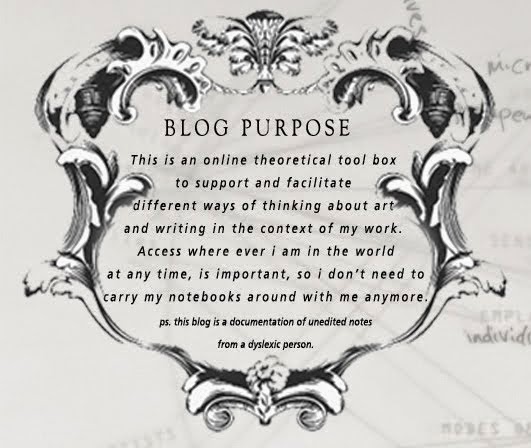Paul O’Neill-
co-productive exhibition-making
This is a collective curatorial methodology.
Af Thomas Soderqvist -
Narrativity in exhibition making - the current enthusiasm is problematic.
Af Thomas Soderqvist -
Narrativity in exhibition making - the current enthusiasm is problematic.
Paul O’Neill-
co-productive exhibition-making
This is a collective curatorial methodology.
Curating definition:
Structures the exhibition experience for the viewer and borders the spatial relations between the
work, where the audience perform their experience of culture. Curating is the
activity that structures the experience for the viewer and the work.
Traditional curating
definition: artists respond to a curatorial proposition, strategy or
imposed structure which resulted in artworks that would not have emerged
without such orchestration.
What Paul O’Neill’s
text is about: A curatorial
experimentation that represents new discursive space around art practice. And
opens up a new way for a group exhibition to be organised, and expands the
traditional/formal methods of curating. Where the surrounds of the viewer can
be experimented with - moved through interacted or contained. He rejects the
notion of autonomous object as primary medium, but where the experience of the
exhibition as a whole becomes the primary medium.
The intention of Coalesce
is to accommodate cross fertilisation of different artistic and curatorial
positions. To use exhibitions as a research tool, explore potential space of
collective co-oporation, artwork operating in the
unseen, question different language of an exhibition can be used,
attempt something unique and space of experimentation.
1.
intentional connections
2.
structural attributes
3.
curatorial overlaps
4.
extend vocabulary
5.
test limitations
He proposes this
as an open approach to the gallery show that demonstrates flexibility of the object
and counter expectations that artists are expected to exhibit their work.
By:
1.
The group exhibition form as a continually
evolving structure.
2.
Revealing and evaluating hidden curatorial components
–the formation, production, dissemination of the work for the viewer.
3.
Close involvement with the artists during all
stages of the exhibition production.
4.
Focus on the spatial context.
5.
Resist thematic implementation, the artists are
not illustrating a subject or coherent
intertextual relationship.
6.
No grand narrative
7.
No single or unified way of reading the
exhibition as work.
8.
Curating and artwork is
not separated.
Step 1: Work
directly with each artist on every aspect of the exhibition.
Step 2: Gather
its form across a series of distinct exhibition-moments.
Step 3: The
exhibition moment being the form of mutating environment of overlapping
artworks.
Step 4: Call on
invitees to activate the exhibition site by considering a possible pedagogical
tool within an ongoing collaborative process.
His spatial co-ordinates are three planes of interaction:
Background – Middle -
Foreground
Consider these co-ordinates with:
1.
proximity of the viewer
2.
to the display
3.
co-authorship
4.
where co-authorship relates to one of the
organisational parameters.
Outcomes:
1. Form part of a continuum- exhibition an unending show
with artists added for each show (outing).
2. the overall exhibition grows over time.
3. Each participant in the exhibition becomes part of a
dialogical structure
Suggests:
The exhibition to be viewed as a ‘landscape’, so
acknowledging the spatial world as a display space.
----------------------------------------------------------------
http://www.museion.ku.dk/2011/12/narrativity-in-exhibition-making-the-current-enthusiasm-is-problematic/
Af Thomas Soderqvist -
Narrativity in exhibition making - the current enthusiasm is problematic.
----------------------------------------------------------------
http://www.museion.ku.dk/2011/12/narrativity-in-exhibition-making-the-current-enthusiasm-is-problematic/
Af Thomas Soderqvist -
Narrativity in exhibition making - the current enthusiasm is problematic.
Exhibition development:
Narrativity: story
Exhibition development:
Narrativity: story telling- bring exhibition to life. Provide a sharing of stories with others, knowledge and communicate an alternative to giving facts.
Rhetorical modes: describes a variety of kinds of writing, classical 4 common modes:
Exposition: Purpose to explain
inform describe analyse info about how the world is.
Argumentation: Purpose – persuasive writing, provide validity of an idea, think deeper about something, urge into action, reasoning to viewer about something. Advertising job evaluation, resume, and satirical rhetoric.
Description: Purpose – recreate, invent or visually present a person, place, event, or action. The reader can paint a picture of what is being described.
Narration: Purpose to tell a story.
Narrativity: story
Exhibition development:
Narrativity: story telling- bring exhibition to life. Provide a sharing of stories with others, knowledge and communicate an alternative to giving facts.
Rhetorical modes: describes a variety of kinds of writing, classical 4 common modes:
1.
Exposition
2.
Argumentation
3.
Description
4.
Narration
Argumentation: Purpose – persuasive writing, provide validity of an idea, think deeper about something, urge into action, reasoning to viewer about something. Advertising job evaluation, resume, and satirical rhetoric.
Description: Purpose – recreate, invent or visually present a person, place, event, or action. The reader can paint a picture of what is being described.
Narration: Purpose to tell a story.

